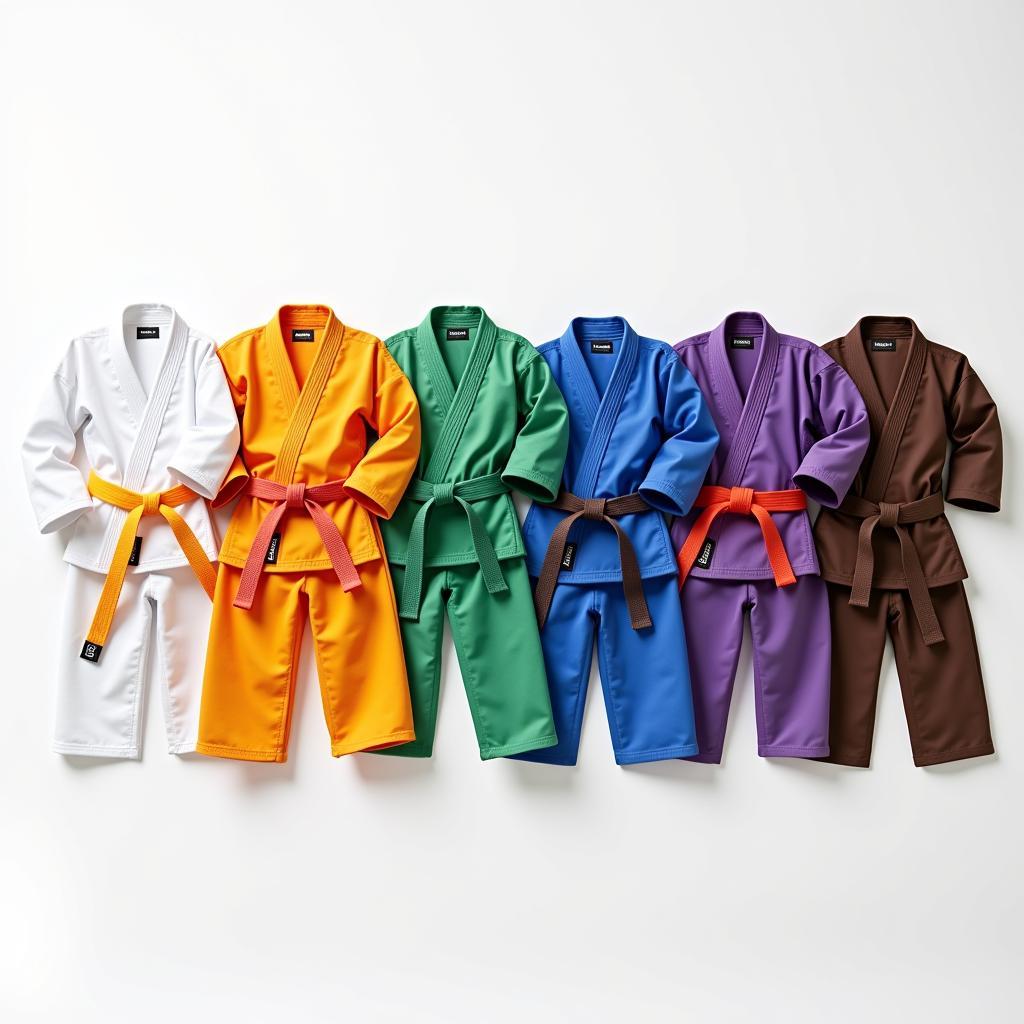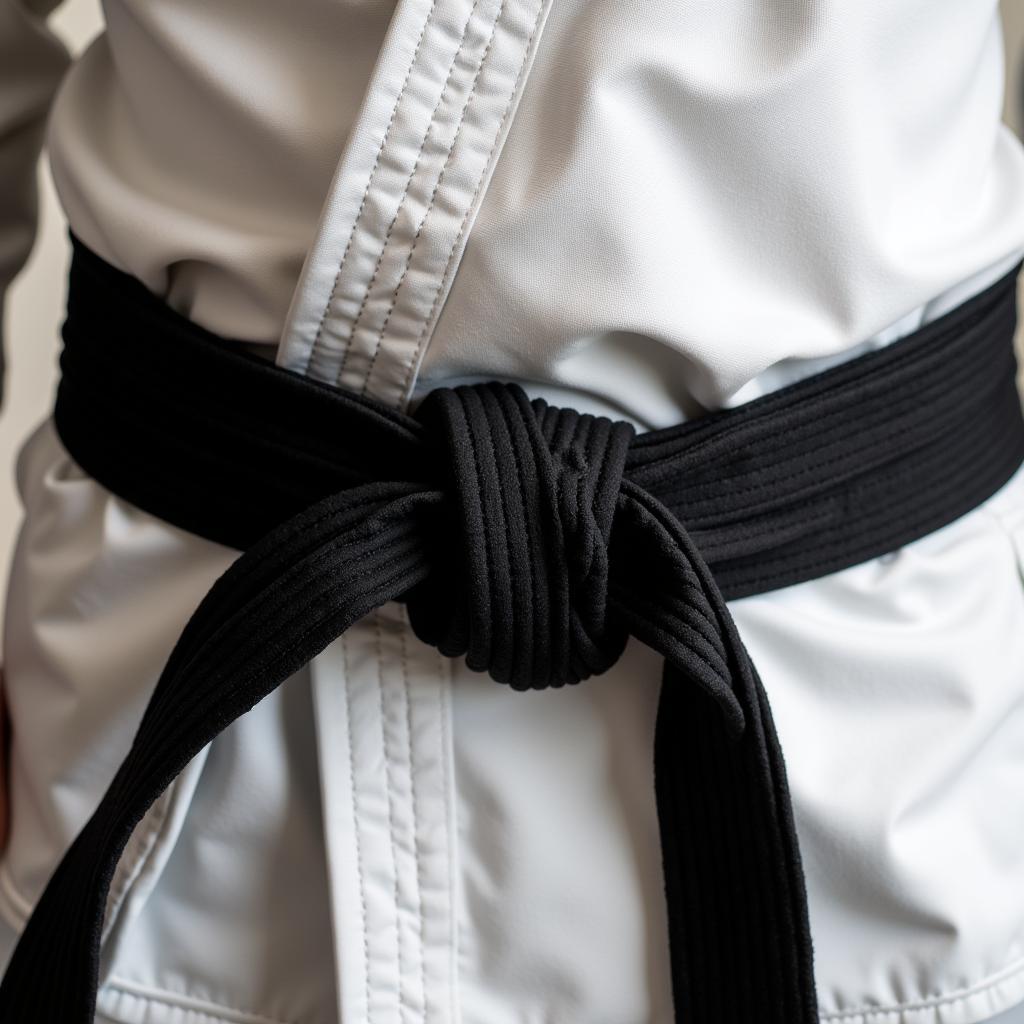Karate belts are more than just colorful accessories; they represent a practitioner’s skill level and journey through the martial art. So, what colors are karate belts, and what do they signify? This comprehensive guide will explore the fascinating world of karate belt colors, their meaning, and the path to achieving each rank.
what are the colors for karate belts
Understanding the Karate Belt System
The colored belt system in karate provides a visual representation of progress and achievement. Each color signifies a different stage of learning, reflecting increasing proficiency in technique, knowledge, and character development. While specific colors and their order can vary slightly between different karate styles (such as Shotokan, Goju-ryu, and Kyokushin), the underlying principles remain consistent.
The Significance of Karate Belt Colors
From the beginner’s white belt to the coveted black belt and beyond, each color holds a unique meaning within the karate world. The progression through these colors reflects a journey of discipline, perseverance, and self-discovery.
Beginner Belts (Kyu Ranks)
- White Belt: Symbolizes purity, innocence, and the beginning of a student’s journey. It represents a blank canvas, ready to be filled with knowledge and skill.
- Yellow Belt: Often represents the rising sun, signifying the first glimpse of understanding and the germination of basic techniques.
- Orange Belt: Represents the growing strength and developing skills of the student as their knowledge expands.
- Green Belt: Symbolizes growth and balance, as the student begins to refine their techniques and deepen their understanding of karate principles.
- Blue Belt: Represents the sky and the depth of knowledge the student is acquiring. It signifies a transition to more advanced techniques and a deeper understanding of karate’s philosophical aspects.
- Purple Belt: Often symbolizes the merging of the sky (blue) and the earth (red/brown – the next belt color in some styles), signifying a blending of basic and advanced techniques.
- Brown Belt: Represents the earth, signifying stability, strength, and the nearing completion of the basic training phase.
 Karate Belt Colors for Beginner Kyu Ranks
Karate Belt Colors for Beginner Kyu Ranks
Advanced Belts (Dan Ranks)
- Black Belt (1st Dan – Shodan): This coveted rank doesn’t signify mastery, but rather the beginning of a true understanding of karate. It represents a solid foundation and the readiness to embark on a deeper exploration of the art.
- Higher Dan Ranks: Beyond the first-degree black belt, further Dan ranks (Nidan, Sandan, etc.) are awarded for continued dedication, advanced skill, leadership, and contributions to karate. These ranks are often indicated by stripes or other markings on the black belt itself.
what are the color of belts in karate
What Color Belts in Karate? FAQs
Many individuals have questions regarding karate belt colors. Here are some commonly asked questions and their answers:
-
How many solid belt colors are there in karate? The number of colored belts varies slightly between styles, but typically ranges from six to eight solid colors before reaching black belt. how many solid belt colors karate
-
What is the order of karate belt colors? While some variations exist, a common order is white, yellow, orange, green, blue, purple, brown, then black.
-
What does it mean to earn a black belt? Earning a black belt is a significant achievement, but it’s not the end of the journey. It marks the beginning of a deeper level of learning and responsibility within the karate community.
 Karate Black Belt Representing Dan Ranks
Karate Black Belt Representing Dan Ranks
Conclusion: Embracing the Journey of Karate Belt Colors
What colors are karate belts? They are a vibrant symbol of progress, dedication, and personal growth within the martial art. Each color represents a milestone achieved, a lesson learned, and a step closer to mastering oneself. Whether you’re a beginner starting with a white belt or an experienced practitioner striving for a higher Dan rank, the journey through the colors of karate belts is a lifelong pursuit of knowledge, discipline, and self-improvement.
what are the belt colors for karate
FAQ
-
What does a red belt in karate mean? (In some styles, red signifies a rank between brown and black, representing significant skill development.)
-
Can you skip a belt in karate? (Generally, no. Progression through the belt system is based on demonstrating proficiency at each level.)
-
How long does it take to get a black belt? (This varies depending on individual dedication, training frequency, and specific style requirements, but it typically takes several years.)
-
Are karate belt colors universal? (While similar, minor variations in colors and order exist across different karate styles.)
-
What is the highest karate belt? (While the 10th Dan is the highest attainable rank, it’s often considered honorary and rarely awarded.)
-
What is the importance of respecting belt ranks? (Respecting belt ranks reflects respect for the knowledge, experience, and dedication of fellow practitioners.)
-
How can I accelerate my progress through the belt system? (Consistent training, dedication to learning, and a positive attitude are key to progressing through the ranks.)
For further support, please contact us at Phone: 0373298888, Email: [email protected] or visit us at 86 Cầu Giấy, Hà Nội. We have a 24/7 customer support team.

